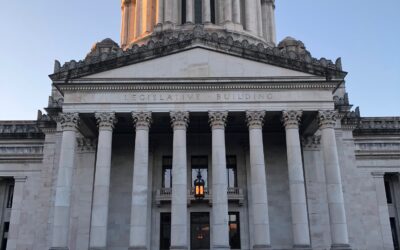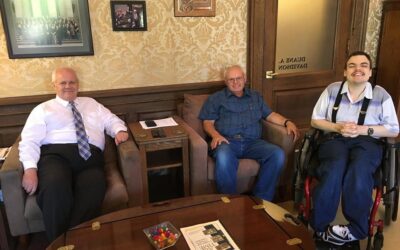A Case Study of the U.S. Senate
By Robert Garrison
American Public University System
Abstract: The U.S. Senate has been called “the world’s greatest deliberative body.” However, if the Senate as a public institution is to be managed and governed more responsibly, people need to have an understanding of how it works its history and its rules. The rules in particular must be examined and some changes could be made. Before change can be discussed however, the following questions should be asked and answered? What is the Senate’s history? What committees does it have and what are their responsibilities? What are its standing rules? How might they be changed? These questions will be answered in this paper using various books and websites.
Thesis
The U.S. Senate has been called “the world’s greatest deliberative body.” However, if the Senate as a public institution is to be managed and governed responsibly, people need to have an understanding of how it works its history and its rules. The rules in particular must be examined and some changes could be made. Before change can be discussed however,, the following questions should be asked and answered? What is the Senate’s history? What committees does it have and what are their responsibilities? What are its standing rules? How might they be changed?
The Beginnings of the Senate
The word “senate” comes from the Latin word “senatus” meaning “council of elders.” It extends all the way back to ancient Rome in the days of the Caesars. Its modern usage means “an assembly or council of citizens having the highest deliberative functions in a government, a legislative assembly of a state or nation. The upper house of the legislature of certain countries, such as the United States, France, Italy, Canada, Ireland, Republic of South Africa, Australia, and some Latin American countries” (Dictionary.com).In a bicameral (two house) legislature the senate or its equivalent is referred to as “the upper house.” In Canada and the U.K., the upper house (called the House of Lords in the U.K. and Senate in Canada) are appointed, not elected and in many of these other countries, the senate, or other named upper house, cannot block legislation or can only act as an advisory body. For many years in both the U.K. and Canada, efforts have been made to reform their upper houses to allow them to be popularly elected and thus be more accountable to the people, but so far, nothing has come of these reform plans.
Our own United States Senate began at the Constitutional Convention in 1787 as part of the Connecticut Compromise. The Connecticut Compromise ensured that each state would have proportional representation in the House of Representatives and equal representation in the Senate. The United States Senate was established by Article II, Section 3 of the U.S. Constitution. In summary, the article provides for:
- Two Senators from each state chosen by the legislatures thereof. (Changed to direct popular election by the Seventeenth Amendment in 1913).
- Staggered six year terms (1/3 of the body chosen every two years)
- Senators must be thirty years of age, must be a citizen of the U.S. for nine years and live in the state that they are to represent in the Senate.
- Vice President of the U.S. shall serve as presiding officer of the Senate and only vote in case of a tie. A President pro tempore may serve in the absence of the Vice-President.
- Can convict and remove federal officials including the President of the United States of impeachable offenses, confirm appointments and ratify treaties.
According to Meese, et, al, (2005) pp. 63-71) the rationale for having senators appointed by state legislatures was to make sure that senators always kept the interests of their home states foremost in their minds. This was changed by the Seventeenth Amendment which provided for the direct popular election of Senators. The reasons for this amendment were: Partisan gridlock in the state legislatures, bribery and scandal, the growth of the Populist Movement and the rise of the Progressive Movement which favored expansion of democracy (see Meese, et, al, (2005, p. 63). The Framers of the Constitution established staggered six year terms for senators so that they could not be swayed by the mood of the moment. According to Robert A. Caro in his book Master of the Senate, Thomas Jefferson asked George Washington why the Framers had agreed to a bicameral legislature, Washington said, “we pour House legislation into the senatorial saucer to cool it” (Caro, 2003, p. 9). The age and residency requirements were instituted because the Framers assumed that senators would be more responsible and mature The Vice-President was chosen as presiding officer of the Senate because, as Roger Sherman said, “If the Vice-President were not President of the Senate, he would be without employment” (Meese, et, al) 2005), p. 66). A second reason was because there was concern that if a Senator presided, one state would effectively have more representation than the others.
Today there are 100 Senators (two from each of the 50 states) Before a Senator can be seated, they must take the following oath: “I do solemnly swear (or affirm) that I will support and defend the Constitution of the United States against all enemies, foreign and domestic; that I will bear true faith and allegiance to the same; that I take this obligation freely, without any mental reservation or purpose of evasion; and that I will well and faithfully discharge the duties of the office on which I am about to enter: So help me God” (Senate.gov). A senator earns $174,000 a year (Senate.gov). Most senators come from a law background, but senators have come from various careers such as teachers, doctors and technical fields such as engendering. The Democratic Party currently has the majority in the Senate with 59 Democrats to 41 Republicans.
A Brief History of the U.S. Senate
The Senate has had an illustrious history. 16 of our 44 Presidents have served as Senators. (Monroe, John Quincy Adams, Jackson, Van Buren, William Henry Harrison, Tyler, Pierce, Buchannan, Andrew Johnson, Benjamin Harrison, Harding, Truman, Kennedy, Lyndon Johnson, Nixon and Obama) (DeGregorio 2009). Caro’s Master of the Senate paints a wonderful picture of the Senate’s history in its first 105 pages and that history will be briefly highlighted here.
The years of 1819-1859 were called the Senate’s “Golden Age” (Caro, 2003, p. 15). During that time, led by the likes of Henry Clay, Daniel Webster and John C. Calhoun (called “the Great Triumvirate”) the Senate debated the great questions of slavery and the territorial expansion of the United States. The Senate was held in high esteem and its members’ speeches were printed and read by the masses. Southern senators such as Calhoun believed in the sovereignty of individual states and they supported slavery. Senators like Webster wanted to save the union. The Union was preserved for forty years before the Civil War broke out. After the war, the Senate’s pace slowed down to the point where it was becoming a subject of ridicule in newspaper cartoons. During the nineteenth century, the Senate was called the “Senate Supreme” because it often stood up against a strong President by blocking legislation. It could even stand up to the judicial branch by refusing to confirm judicial appointments and refusing to convict judicial officials of impeachment.
Two events of the twentieth century illustrate the Senate’s supremacy. First, was the battle over the Versailles Treaty that ended WWI. President Woodrow Wilson fought for the ratification of the treaty, but Senator Henry Cabot Lodge Sr opposed the treaty because of its establishment of a League of Nations. Lodge and other isolationist Republicans opposed the League because they feared it would undermine the sovereignty of the United States. Both sides in the struggle went around the country giving speeches; Wilson for the League and Republican Senators against it. Wilson even suffered a debilitating stroke during his cross-country speaking tour (Caro, 2003, p. 44). Lodge subjected the treaty to every possible delay tactic. He had the 268 page treaty read into the record of the Senate Foreign Relations Committee (Caro, 2003, p. 42). Lodge offered 14 Amendments to the treaty, but Wilson refused to accept the changes and the treaty was defeated.
A second occasion on which the Senate showed its supremacy was during FDR’s “court packing plan.” The Supreme Court had struck down many New Deal policies as unconstitutional. FDR’s rationale for his proposal was that the Constitution did not specify the number of justices that could be on the Court. FDR wanted to add six pro-New Deal justices to the Court. When presented with the plan, the Democratic Senate leadership rejected the plan almost unanimously as undemocratic. As with the Versailles Treaty, both sides gave speeches and took to the radio airwaves, but the plan was defeated. The Senate “was created to protect the minority from the tyranny of the majority” (Caro, 2003, p. 59). And the Senate stood firm with the armor that the Framers had given it. So immense was the impact of FDR’s defeat in the “court packing” scheme that “not one additional piece of (New Deal) legislation passed the Senate” (Caro, 2003, p. 64). The title of Caro’s book (Master of the Senate) refers to the time when President Lyndon Johnson served as Majority Leader of the Senate from 1955-1960, Johnson established “The Johnson Rule” which mandated that freshmen senators receive a major committee assignment (Caro, 2003, p. 565). Johnson also “engineered the passage of the 1957 and 1960 Civil Rights Acts” and persuaded his Southern colleges not to filibuster these bills Johnson’s “leadership on the issue marked his departure from a regional political leader to a national statesman” (DeGregorio, 2009, pp. 568-569). Johnson signed much more successful civil rights legislation after he became president.
The Senate Today- Its Committee Structure
An important part of the legislative process is a bill’s passage through a committee. The Senate has 16 “standing” (permanent) committees. They will be listed and briefly described below:
- Agriculture, Nutrition and Forestry Committee- Handles agricultural matters such as farm bills, etc.
- The Appropriations Committee- “writes the legislation that allocates federal funds to the numerous government agencies, departments, and organizations on an annual basis. Appropriations are limited to the levels set by a Budget Resolution, drafted by the Senate Budget Committee” (Senate.gov). It is the largest committee in the Senate with 30 members.
- Armed Services Committee- Conducts comprehensive study and review of matters relating to the common defense policy of the United States.
- Committee on Banking, Housing and Urban Development- Oversees banking and financial institutions, the building of nursing homes, housing and urban development, etc.
- Budget Committee- Sets out the budget blueprint of the United States while other committees work out legislation dealing with taxes and other matters.
- Committee on Commerce, Science and Transportation- Oversees the Coast Guard and other maritime agencies science and technology, standards and measurements and all transportation agencies, etc.
- Committee on Energy and Natural Resources- Oversees energy policy, national parks and forests, water and power, etc.
- Committee on Environment and Public Works- Deals with air, water and noise pollution, construction of highways and recycling programs, etc.
- Committee on Finance- Oversees all matters related to the national debt, social security, tariffs and interstate transfer of durable goods, etc.
- Foreign Relations Committee- Oversees U.S. boundaries, diplomatic services, international conferences, international law, declaration of war, treaties and executive agreements, the United Nations, etc.
- Committee on Health, Labor, Education and Pensions (HELP)- Deals with aging, arts and humanities, child labor and all labor issues, wages, public health, student loans, etc.
- Homeland Security & Governmental Affairs Committee- Oversees the Achieves of the United States, The Federal Civil Service, the Census and other statistical data, the municipal affairs of the District of Columbia, the Postal Service, etc.
- Judiciary Committee- Oversees appointments of representatives and judicial nominations, Constitutional Amendments, the Patent Office, immigration, holidays and celebrations, etc. (This committee is probably the most visible to the nation as it is the sight of nationally televised Supreme Court confirmation hearings)
- Rules Committee- Oversees the rules of the Senate, the Government Printing Office, senate operations and buildings, etc.
- Committee on Small Business and Entrepreneurship- Oversees the Small Business Administration (SBA)
- Veterans Affairs Committee- Oversees compensation, education and health, national cemeteries, etc for veterans. (All information on committees taken from Senate.gov).
Standing Rules of the Senate- Cloture
The Senate has 44 Standing Rules. For the sake of space, only Rule XXII (22) will be discussed. This rule pertains to cloture motions (cloture meaning to end debate). The rule reads in part, “Is it the sense of the Senate that the debate shall be brought to a close?” And if that question shall be decided in the affirmative by three-fifths of the Senators duly chosen and sworn — except on a measure or motion to amend the Senate rules, in which case the necessary affirmative vote shall be two-thirds of the Senators present and voting — then said measure, motion, or other matter pending before the Senate, or the unfinished business, shall be the unfinished business to the exclusion of all other business until disposed of” (Senate.gov). In other words, 60 votes are needed to invoke cloture and end debate. This rule as often used to maintain the filibuster (endless debate.) The filibuster is used to block or kill a bill (and often controversial judicial nominees) by “talking them to death.” Rule XXII should be amended to invoke cloture by a simple majority (51 votes) and once cloture is invoked, a separate roll call vote should be taken on the previous question. It is beneath the dignity of the Senate to engage in endless debate! An up or down vote should be taken on every bill or nomination that comes before the Senate.
Recommended Constitutional Changes.
In this class, we are sometimes asked what Constitutional changes we would make to public institutions. Often the filibuster is used to block controversial judicial nominees. The Senate far exceeds its “advice and consent” role by subjecting nominees to nationally televised confirmation hearings that can sometimes be difficult and embarrassing for the nominee, as in the cases of Robert Bork and Clarence Thomas. Therefore, a Constitutional Amendment should be adopted that provides for the direct election of the Supreme Court in the same way that the Senate was subjected to direct election by the Seventeenth Amendment. The Amendment should provide that:
- The Supreme Court consisting of nine justices should be directly elected in a nationwide vote.
- All nine justices should be subject to reelection every four years.
- A mandatory retirement age of 75 years of age should be imposed.
This Constitutional Amendment should be adopted because the Judicial Branch is the only branch of government that is “protected” from the will of the people (though people will argue it is not because the President and Senators are directly elected) However, many states directly elect their State Supreme Courts, so why shouldn’t the nation as a whole elect their highest court? Such an Amendment would probably never be adopted because both the House and the Senate would have to agree to it by a supermajority and the Senate would likely resent popular intrusion into an area that it holds sacred. However, more power given to the people would strengthen our Democratic Republic and make our government more accountable to the people.
Discussion:
The reason this writer chose to write about the Senate is because this writer served as a “senator” in a community college student government. This writer served on the Bylaws and Election Committees and enjoyed it very much. This writer made important changes to the bylaws (such as allowing senators to serve on the Bylaws Committee and relaxing the attendance requirements for senate sessions) This writer has watched U.S. Senate coverage on C-SPAN2 for many years and it was fun being called “Senator Garrison” in the student government. This writer hopes to someday serve in the U.S. Senate for at least thirty years (five terms).
Conclusion
The U.S. Senate is a great institution. It has been called “the world’s greatest deliberative body” and if it were to adopt the rule changes that have been suggested here (such as getting rid of the filibuster and allowing for the direct election of the Supreme Court) perhaps it would be even more effective in dealing with the People’s business and would not get bogged down in petty partisan bickering over polarizing judicial nominees and other matters. The Senate is a great body, but the rule changes that have been suggested are meant to help restore even more of its greatness and prestige!
References
- Caro Robert A. (2002). Master of the senate New York: Vintage books.
- DeGregorio, William A. (2009). The complete book of U.S. presidents Fort Lee, NJ. Barricade Books.
- Dictionary.com (2010) Senate Retrieved 15 May 2010 from: http://dictionary.reference.com/browse/senate
- Meese, Edwin III Spaulding, Mathew, and Forte, David (2005). The heritage guide to the constitution. Washington D.C. Regnery Publishing Inc.
- Senate.gov (2010) Retrieved 15 May 2010 from: http://www.senate.gov/




